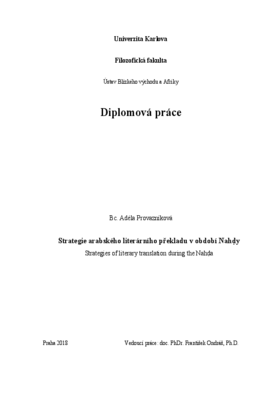Strategie arabského literárního překladu v období Naḥdy
Strategies of literary translation during the Naḥda
diplomová práce (OBHÁJENO)

Zobrazit/
Trvalý odkaz
http://hdl.handle.net/20.500.11956/103830Identifikátory
SIS: 187748
Kolekce
- Kvalifikační práce [24991]
Autor
Vedoucí práce
Oponent práce
Bielický, Viktor
Fakulta / součást
Filozofická fakulta
Obor
Arabistika - Český jazyk - specializační studium
Katedra / ústav / klinika
Katedra Blízkého východu
Datum obhajoby
11. 9. 2018
Nakladatel
Univerzita Karlova, Filozofická fakultaJazyk
Čeština
Známka
Výborně
Klíčová slova (česky)
překladatelské strategie|moderní arabská literatura|nahḍa|populární literatura|Adíb Isḥáq|Labíba Hášim|kulturní kontaktKlíčová slova (anglicky)
translation strategies|modern Arabic literature|Nahḍa|paraliterature|Adib Ishaq|Labiba Hashim|cultural encounterBc. Adéla Provazníková Strategie arabského literárního překladu v období Nahḍy Abstrakt: Diplomová práce se věnuje problematice uměleckého překladu v arabském světě během nahḍy. Spadá do rámce deskriptivních studií překladu a metodologicky využívá modelu Gideona Touryho (1995), od něhož se odvíjí struktura i cíle práce. Po nástinu literárně-historického kontextu se zaměřuje na systematický popis přístupů k překladu v daném období na základě sekundárních textů a zjišťuje, že překladová terminologie i požadavky na překladatele se v 19. století měnily a teprve ustavovaly. Těžištěm práce je textová analýza dvou románových a tří povídkových textů, která odhaluje konkrétní překladatelské strategie. Ukazuje se, že arabští překladatelé v koloniálním kontextu zacházeli se zdrojovými texty tvůrčím způsobem a přizpůsobovali přeložené texty kulturním a historickým specifikům arabského čtenáře dané doby. Klíčová slova: překladatelské strategie, moderní arabská literatura, nahḍa, populární literatura, Adíb Isḥáq, Labíba Hášim, kulturní kontakt
Bc. Adéla Provazníková Strategies of literary translation during the Nahḍa Abstract: The thesis deals with the topic of literary translation in the Arab world during the Nahḍa. It falls within the framework of descriptive translation studies and is based methodologically on Gideon Toury's model (1995), which determines its structure and goals. Following a brief historical and literary context the thesis systematically describes attitudes towards translation in given period and finds that translational terminology and requirements were changing during the 19th century and only yet stabilizing. The core of this thesis lies in the textual analysis of two novels and three short stories, which reveal individual translational strategies. It shows that Arab translators in the colonial context dealt with the source text in a creative manner and accommodated translated texts to the cultural and historical particularities of a contemporary Arab reader. Keywords: translation strategies, modern Arabic literature, Nahḍa, paraliterature, Adib Ishaq, Labiba Hashim, cultural encounter
